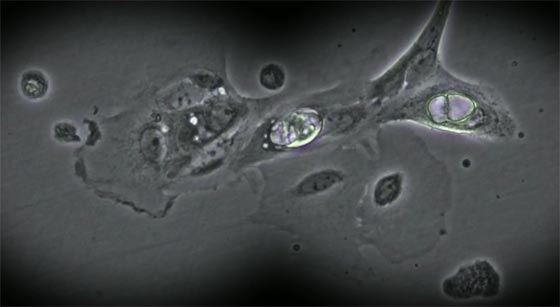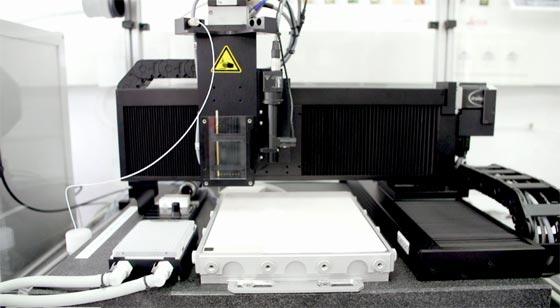A Spanish team, consists of 12 researchers, has discovered a way to detect disease earlier.
They have used Nanotechnology to differentiate cancer cells from healthy cells. With the Nanotechnology, they approach the physical properties of the cells.
This is a project of the CSIC (High Center of Scientific Researches), but with European funding.
Nanoforcells, which would be an abbreviation of the name 'Nanotechnology for cells', is a project of CSIC Biomechanics Laboratory whose main objective is to study the mechanical properties of the cells to differentiate cancer cells from healthy cells through their properties physical. It is one of the projects that have been released to mark the 2013 Science Week, which is celebrated throughout Spain.
Through a new avenue of research, a team of 12 people led by researcher Montserrat Calleja, uses micro and nanofabrication tools for basic cell information; so we can develop future forms of early diagnosis of diseases such as cancer , among others, as Calleja explained to RTVE.es.
Nanoforcells is a basic research project that began in 2011, funded with EUR 1.5 million European Research Council, which aims to provide tools for hospitals to diagnose disease in about ten years.
The Physics, Montserrat Calleja, explained so far and in general, research was focused on the chemical properties of the cells. This avenue of research "has given very good results", in her view, and it allowed inhibit malignant cells through a biochemical pathway.
The investigation of the physical properties of the cells, through Nanotechnology, is a relatively new scientific approach, that is developing around the world and in the laboratory at the Institute of Microelectronics (IMM), in the CSIC.
Nanotechnology is the science that studies how the properties of materials change when their dimensions are reduced to the size of a nanometer, I mean, one millionth of a millimeter. To get an idea of the tiny size, equivalent to a DNA molecule.
"We seek to determine the mechanical properties of many cells very quickly, reliably and consistently" stressed Calleja, who said "is a tool and can allow other treatments”. She also said that “The cancer cells are vibrating, as opposed to healthy, which are stiffer”.

A cell view with instrumentation of the Biotechnology Laboratory of CSIC
The researcher (the Doctor Calleja) has indicated that the cells are living organisms that pass through different states that occur in different physical properties. A healthy cell and a cancer cell can be identified by properties such as elasticity, for example.
Thus the cancer cells are vibrating, as opposed to healthy , which are more rigid; but for detecting this movement, in an extremely small size, it is necessary to use nanotechnology.
Nanoforcells team, composed of scientists from different disciplines --Biology, Physics, Engineering or Math--, with biomechanical sensors studied three types of cells: healthy, non-malignant cells, which do not produce metastasize and malignant cells that do occur.

Instrument for biofunctionalization of the nanomechanical sensors
Sensors, which themselves are manufactured in the laboratory, are nanomanufactu silicon rods deform when biomolecules interact on its surface, since each protein has a different weight. The team measured their physical response, allowing them to detect whether a given protein is in a sample. The already have detected more than 50 different relevant analytes.
Also, as revealed Calleja, believe that the vibration could be related to the ability of cells of blood vessels or through narrow pores, reaching and metastasize to distant organs.
Calleja is working since 2005, in the IMM, in different lines of research. They started with a team of four people to reach the 12 scientists, some very young-2011. Have focused on developing instrumentation line "fundamental for understanding the mechanism of signal transduction via mechanical sensors”.
They also have a line of optomechanical, ie optical and mechanical sensors to miniaturize the size of a silicon nanowire, to weigh individual proteins. Finally, indulge in the mechanical characterization of cells.
In 2008, the team created the company Mecwins, in the technology park of Madrid, with the objective to develop and monetize molecular diagnostic tools that create in the IMMThey are some unique tools, that answer questions, related to biology and that they do not exist on the market.
Moreover they have patented various methods and mechanisms through CSIC, whose profits go into common stock of the institution, as pointed Montserrat Calleja, who has emphasized the jobs that have been creating these projects.
The researcher also noted that during his research have been taking risks since their work has "no guarantees" and has sentenced young researchers now "Hard times". "The competition is great and we are looking for established European projects. Youth represent the creative force of the research groups" said.
Regarding the reduction of funds for science in Spain since 2009, CSIC scientist commented that "no money to advance a competitor can make you overcome" and has warned that a project that does not get the funding may suffer delays of five to 10 years.
I hope that you do think that it is as interesting as I do.
Till soon, kind regards,
Luis.
Sponsored by Costaluz Lawyers
Please click down here:
